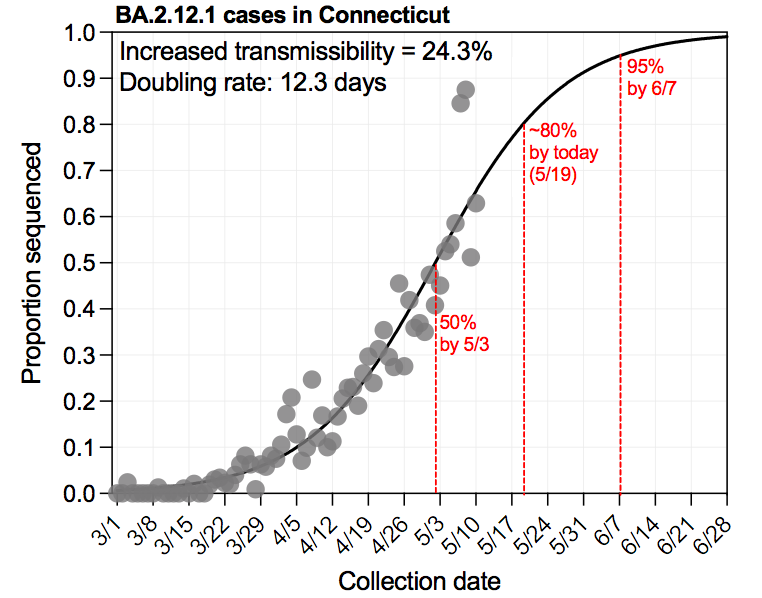⚡️4/15 Connecticut #SARSCoV2 variant surveillance report 🧬
@CovidCT | @jacksonlab | @CTDPH | @YaleSPH
- B.1.1.7 📈
- B.1.526 📉
- Still not much P.1 & B.1.351
short 🧵 | Report 👇
covidtrackerct.com/variant-survei…
@CovidCT | @jacksonlab | @CTDPH | @YaleSPH
- B.1.1.7 📈
- B.1.526 📉
- Still not much P.1 & B.1.351
short 🧵 | Report 👇
covidtrackerct.com/variant-survei…

2/9 While we continue to see the rapid decline of non-VOCs/VOIs, the competition between B.1.1.7 & B.1.526 is quite interesting, and could have significant public health importance. Currently B.1.1.7 is "winning", though things could rapidly change as more people get vaccinated. 

3/9 For the first time we saw B.1.1.7 📉 from TaqPath data, which could mean that it is slowing down (it has to at some point). Below I also plotted the B.1.1.7 frequency estimates from our sequencing data, which has tracked with TaqPath and importantly still shows B.1.1.7 📈 

4/9 So I am hesitant to say that the 📈 trajectory of B.1.1.7 is starting to slow down based on the TaqPath data. We now have enough data to expect B.1.1.7 to keep 📈 until it completely dominates (>90%), or until the selection landscape changes w/ 💉
5/9 The B.1.526 story is interesting. 1st, it is a complicated lineage, with 2 new sub-lineages ("sister" lineages?) and 3 primary mutations within the spike RBD:
L452R, S477N, E484K
As you can see, they have very different patterns which could be functionally relevant.
L452R, S477N, E484K
As you can see, they have very different patterns which could be functionally relevant.

6/9 What's interesting is that B.1.526 (+E484K or S477N) and B.1.526.2 (+S477N) were 📈 as fast as B.1.1.7, but now both are on the 📉.
B.1.526.1 (+L452R), meanwhile, is still 📈. Perhaps this is a blip in the data, or perhaps their is something real to this.🤷♂️
B.1.526.1 (+L452R), meanwhile, is still 📈. Perhaps this is a blip in the data, or perhaps their is something real to this.🤷♂️

7/9 The L452R mutation on B.1.526.1 is notable as it is also found on the VOCs B.1.427/9 (first detected in CA) that are known to reduce the efficacy of some monoclonal antibodies. However, B.1.427/9 haven't been much of an issue in CT, and are collectively <3% since March. 

8/9 The decline in B.1.526, and the fact that B.1.351 & P.1 have taken hold in CT, means that the frequency of viruses in CT with the E484K mutation has also 📉. I'll take this as good news with the caveat that other mutations are also likely important for immune evasion. 

9/9 This week I'd like to highlight the work by @AndersonBrito_ who was instrumental in setting up our weekly reports. I am so grateful to have Anderson on our team 🙏
His amazing data processing python scrips and nextstrain code can be found here:
github.com/andersonbrito/…
His amazing data processing python scrips and nextstrain code can be found here:
github.com/andersonbrito/…
• • •
Missing some Tweet in this thread? You can try to
force a refresh















